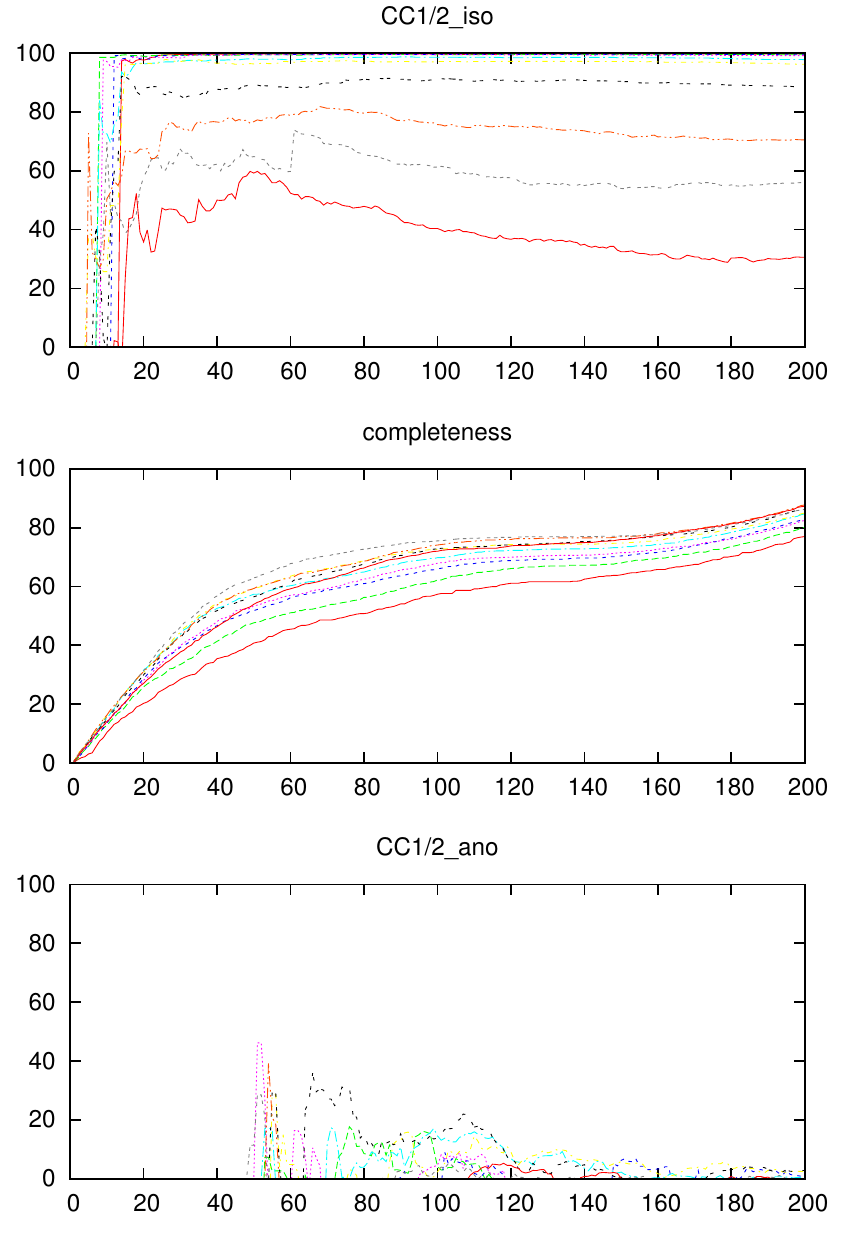Xds maxcc12: Difference between revisions
(start) |
No edit summary |
||
| Line 14: | Line 14: | ||
set out 'xds_maxcc12.ps' | set out 'xds_maxcc12.ps' | ||
set yrange [0:100] | set yrange [0:100] | ||
set xlabel "frame" | |||
set ylabel "%" | |||
set multiplot layout 3,1 | set multiplot layout 3,1 | ||
set title "CC1/2_iso" | set title "CC1/2_iso" | ||
| Line 46: | Line 49: | ||
which you save as plot_maxcc12.rc in your ~/bin or (as root) in /usr/local/bin . | which you save as plot_maxcc12.rc in your ~/bin or (as root) in /usr/local/bin . | ||
Now, after processing a dataset with XDS, you can simply use plot_maxcc12.rc and get | Now, after processing a dataset with XDS, you can simply use plot_maxcc12.rc and get a plot like | ||
[[File:xds_maxcc12.png]] | [[File:xds_maxcc12.png]] | ||
The plot is useful because it shows you the cumulative influence of the frames on CC<sub>1/2</sub> and completeness of ten resolution shells (to change that number, you must modify the script). The highest resolution shell us usually the lowest curve (red); the curves above are lower resolution shells. (To get the legend which maps the colors and linetypes to resolution range numbers, remove the "set nokey" line in the script) | |||
The example plot shows that CC<sub>1/2</sub> is highest around frame 60 to 70 and then gets lower due to radiation damage. However it also makes clear that around frame 60, the completeness is only about 50%. In this case, the anomalous signal is practically just noise. | |||
Revision as of 16:10, 3 February 2016
To analyze XDS_ASCII.HKL in terms of the detailed course of CC1/2 by frame number and resolution, you could use the program XDS_MAXCC12 .
You also need a script such as
#!/bin/bash xds_maxcc12 XDS_ASCII.HKL > xds_maxcc12.log # xds_maxcc12 has options for resolution range and number of bins grep a$ xds_maxcc12.log > temp.a grep c$ xds_maxcc12.log > temp.c grep d$ xds_maxcc12.log > temp.d paste temp.a temp.c temp.d | sed -e 's/a. //' -e 's/c. //' > temp.dat gnuplot<<eof set term postscript color portrait set out 'xds_maxcc12.ps' set yrange [0:100] set xlabel "frame" set ylabel "%" set multiplot layout 3,1 set title "CC1/2_iso" # adding labels to the lines make the plot ugly so remove them; # but if you want to know which line is which resolution range then # comment out the next line: set nokey plot 'temp.dat' us 1:2 w li,'temp.dat' us 1:3 w li,'temp.dat' us 1:4 w li,\ 'temp.dat' us 1:5 w li,'temp.dat' us 1:6 w li,'temp.dat' us 1:7 w li,\ 'temp.dat' us 1:8 w li,'temp.dat' us 1:9 w li,'temp.dat' us 1:10 w li,'temp.dat' us 1:11 w li set title "completeness" plot 'temp.dat' us 1:12 w li,'temp.dat' us 1:13 w li,'temp.dat' us 1:14 w li,\ 'temp.dat' us 1:15 w li,'temp.dat' us 1:16 w li,'temp.dat' us 1:17 w li,\ 'temp.dat' us 1:18 w li,'temp.dat' us 1:19 w li,'temp.dat' us 1:20 w li,'temp.dat' us 1:21 w li set title "CC1/2_ano" plot 'temp.dat' us 1:22 w li,'temp.dat' us 1:23 w li,'temp.dat' us 1:24 w li,\ 'temp.dat' us 1:25 w li,'temp.dat' us 1:26 w li,'temp.dat' us 1:27 w li,\ 'temp.dat' us 1:28 w li,'temp.dat' us 1:29 w li,'temp.dat' us 1:30 w li,'temp.dat' us 1:31 w li unset multiplot quit eof rm temp.a temp.c temp.d temp.dat # next line: replace okular with your favourite postscript viewer okular xds_maxcc12.ps # convert to pdf; this compresses and makes it easier to print it ps2pdf xds_maxcc12.ps xds_maxcc12.pdf # you could now use a PDF viewer rm xds_maxcc12.ps
which you save as plot_maxcc12.rc in your ~/bin or (as root) in /usr/local/bin . Now, after processing a dataset with XDS, you can simply use plot_maxcc12.rc and get a plot like
The plot is useful because it shows you the cumulative influence of the frames on CC1/2 and completeness of ten resolution shells (to change that number, you must modify the script). The highest resolution shell us usually the lowest curve (red); the curves above are lower resolution shells. (To get the legend which maps the colors and linetypes to resolution range numbers, remove the "set nokey" line in the script)
The example plot shows that CC1/2 is highest around frame 60 to 70 and then gets lower due to radiation damage. However it also makes clear that around frame 60, the completeness is only about 50%. In this case, the anomalous signal is practically just noise.
